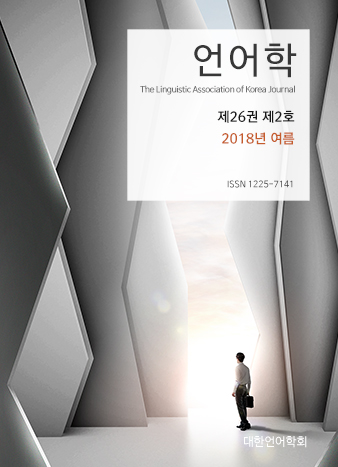대한언어학회 전자저널

-
The Why-not Construction in Korean: A Direct Interpretation Approach
-
L2 Acquisition of Raising Revisited: The Role of the Experiencer Phrase
-
How Universities in Korea and the US Position Themselves in Brochures
-
A Study of Learning Strategies in a Flipped Class Based on Logistic Regression Analysis
-
A Study on the Effects of a TETE Class on English Learners’ Motivation and Anxiety
-
Oral versus Written English Grammar: Evidence from Korean Adult Learners’ Data
-
The Effects of Dictogloss Tasks on EFL Learners’ Syntactic Development
26권 2호 (2018년 6월)
- Intentionality, Purpose, and Tasi ‘Again' in Korean
-
Juwon Lee
Pages : 147-173
Abstract
Keywords
# repetitive reading # pseudo-repetitive reading # purpose-repetitive reading # restitutive reading # tasi # again # intentionality # modality # Korean
References
- Anscombe, G. E. M. (2000). Intention. Cambridge, MA: Harvard University Press.
- Beck, S., & Gergel, R. (2015). The diachronic semantics of English again. Natural Language Semantics, 23, 157-203.
- Beck, S. (2005). There and back again: A semantic analysis. Journal of Semantics, 22(1), 3-51.
- Beck, S. (2006). Focus on again. Linguistics and Philosophy, 29(3), 277-314.
- Bratman, M. E. (1987). Intentions, plans, and practical reason. Cambridge, MA: Harvard University Press.
- Chung, C., & Kim, J.-B. (2008). Korean serial verb constructions: A construction-based approach. Studies in Generative Grammar, 18(4), 559-582.
- Chung, T. (1993). Argument structure and serial verbs in Korean. Unpublished doctoral dissertation, The University of Texas at Austin.
- Dowty, D. (1979). Word meaning and Montague Grammar. Kluwer Publishers.
- Fabricius-Hansen, C. (1983). Wieder ein wieder? Zur semantik von wieder. In R. Baeuerle, C. Schwarze, & A. von Stechow (Eds.), Meaning, use and interpretation of language (pp. 97-120). Berlin: De Gruyter.
- Fabricius-Hansen, C. (2001). Wi(e)der and again(st). In C. Fery & W. Sternefeld (Eds.), Audiatur Vox Sapientiae: A Festschrift for Arnim von Stechow (pp. 101-130). Berlin: Akademie Verlag.
- Grano, T. (2016). A coercion-free semantics for intend. In Proceedings of the 51st Chicago Linguistics Society (CLS), 213-223. Chicago Linguistics Society.
- Grano, T. (2017). The logic of intention reports. Journal of Semantics, 34(4), 587-632.
- Inman, M. V. (1993). Semantics and pragmatics of colloquial Sinhala involitive verbs. Unpublished doctoral dissertation, Stanford University.
- Jackendoff, R., & Culicover, P. (2003). The semantic basis of control in English. Language, 79, 517-556.
- Jäger, G., & Blutner, R. (2003). Competition and interpretation: The German adverb wieder ('Again'). In E. Lang, C. Maienborn, & C. Fabricius-Hansen Eds.), Modifying adjuncts (Interface Explorations 4) (pp. 393-416). Berlin: Mouton de Gruyter.
- Kamp, H., & Rossdeutscher, A. (1994). DRS-construction and lexically driven inference. Theoretical Linguistics, 20, 165-235.
- Klein, W. (2001). Time and again. In C. Fery & W. Sternefeld (Eds.), Audiatur Vox Sapientiae: A Festschrift for Arnim von Stechow (pp. 267-286). Berlin: Akademie Verlag.
- Lakoff, G. (1970). Irregularity in syntax. New York, NY: Holt, Rinehart, and Winston.
- Lee, J. (2012). Change of state verb and syntax of serial verb constructions in Korean: An HPSG account. In Proceedings of the Poster Session of the West Coast Conference on Formal Linguistics (WCCFL), Coyote Papers: Working Papers in Linguistics 20, 57-65.
- Lee, J. (2014a). Two types of serial verb constructions in Korean: Subject-sharing and index-sharing. In Proceedings of the 21st International Conference on Head-Driven Phrase Structure Grammar (HPSG), 135-155.
- Lee, J. (2014b). Multiple interpretations and constraints of causative serial verb constructions in Korean. In Proceedings of the 38th Annual Meeting of the Berkeley Linguistics Society (BLS), 288-305.
- Lee, J. (2015). An Intention-based account of accomplishments in Korean. Unpublished doctoral dissertation, The University of Texas at Austin.
- Lee, J. (2016). Towards a unified account of resultative constructions in Korean. In Proceedings of the 30th Pacific Asia Conference on Language, Information and Computation (PACLIC), 501-510.
- Lee, J. (2017). Semantic taxonomies and tasi ‘again’ in Korean. The Linguistic Association of Korea Journal, 25(4), 59-81.
- McCawley, J. D. (1968). The role of semantics in a grammar. In E. Bach, & R. Harms (Eds.), Universals in linguistic theory (pp. 124-169). New York: Holt, Rinehart and Winston.
- Oh, S.-R. (2009). On the semantics of again: A crosslinguistic perspective. The Journal of Modern British & American Language & Literature, 27(4), 221-239.
- Oh, S.-R. (2015). A crosslinguistic semantic analysis of again. Studies in Generative Grammar, 25(4), 851-872.
- Pedersen, W. A. (2015). A scalar analysis of again-ambiguities. Journal of Semantics, 32, 373-424.
- Pittner, K. (2003). Process, eventuality and wieder/again. In E. Lang, C. Maienborn, & C. Fabricius-Hansen (Eds.), Modifying adjuncts (Interface Explorations 4) (pp. 365-391). Berlin: Mouton de Gruyter.
- Searle, J. R. (1983). Intentionality: An essay in the philosophy of mind. Cambridge, MA: Cambridge University Press.
- Sinhababu, N. (2009). The Humean theory of motivation reformulated and defended. Philosophical Review, 118, 465-500.
- Sinhababu, N. (2013). The desire-belief account of intention explains everything. Noûs, 47, 680-696.
- Stechow, A. von. (1995). Lexical decomposition in syntax. In U. Egli, P. E. Pause, C. Schwarze, A. von Stechow, & G. Wienold (Eds.), Lexical knowledge in the organization of language (pp. 81-118). Amsterdam, The Netherlands: John Benjamins.
- Stechow, A. von. (1996). The different readings of wieder 'again': A structural account. Journal of Semantics, 13, 87-138.
- Stechow, A. von. (2003). How are results represented and modified? Remarks on Jäger & Blutner’s anti-decomposition. In E. Lang, C. Maienborn, & C. Fabricius-Hansen (Eds.), Modifying adjuncts (Interface Explorations 4) (pp. 517-454). Berlin: Mouton de Gruyter.
- Wechsler, S., & Noh, B. (2001). On resultative predicates and clauses: Parallels between Korean and English. Language Sciences, 23, 391-423.
- Yoon, J.-H. (2007). Tasi vs. tto. [in Korean] Language and Information, 11(2), 1-22.
- Zwicky, A. M., & Sadock, J. M. (1975). Ambiguity tests and how to fail them. In Kimball, J. P. (Ed.), Syntax and semantics, vol. 4 (pp. 1–36). New York: Academic Press.